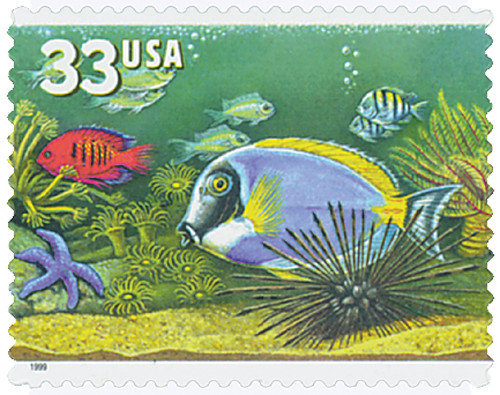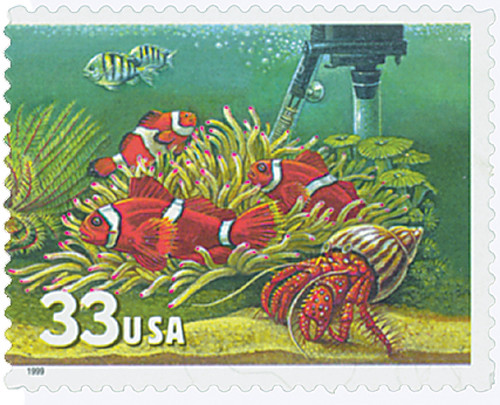
# 3317-20 - 1999 33c Aquarium Fish
US #3317-20
1999 Aquarium Fish
- Honors freshwater and marine aquarium fish and the hobby of keeping and/or raising them
- The first US stamps illustrated by artist Teresa Fasolino (she had previously designed stamps for the United Nations)
Stamp Category: Commemorative
Value: 33¢ First Class Mail Rate
First Day of Issue: June 24, 1999
First Day City: Anaheim, California
Quantity Issued: 141,175,000
Printed by: Banknote Corporation of America
Printing Method: Offset
Format: Panes of 20 (Horizontal 4 across, 5 down)
Perforations: 11.5 x 11.4 (Die-cut simulated perforations) (Rotary in-line die cutter)
Tagging: Block tagging
Why the stamp was issued: According to the USPS, these four stamps were issued in celebration of “one of America’s most rapidly growing and popular hobbies” – aquarium keeping.
About the stamp design: The design pictures a continuous scene of a reef in an aquarium showing coral, sea anemones, sponges, fish, and more. At the top of the selvage are the words “AQUARIUM FISH.” The bottom selvage includes the names of the 23 species pictured on the stamps. The stamps were the first US issues designed by New York City artist Teresa Fasolino. She painted the aquarium creatures as well as four pieces of equipment regularly seen in fish tanks: a skimmer, thermometer, power head, and heater.
First Day City: The First Day of Issue Ceremony was held at the Anaheim Convention Center in California on the first day of the Postage Stamp Mega-Event. Speakers included a tropical reef curator at the Aquarium of the Pacific, Long Beach California. The stamps had been revealed for the first time several hours before the ceremony. They were unveiled underwater at the Long Beach Aquarium of the Pacific.
History the stamp represents: People have been collecting fish in containers for thousands of years. At least 4,500 years ago, the ancient Sumerians kept fish in artificial ponds. One of the premier cultures to successfully breed fish was the Chinese, who later passed their knowledge on to the Japanese. Fishkeeping didn’t become an established hobby until the 1800s, when the relationship between oxygen, animals, and plants became better known.
The all-glass aquarium that many people now use became available in the 1960s. Popular aquarium fish for those new to the hobby are angelfish, tetras, guppies, mollies, and platies. A primary requirement for keeping aquarium fish healthy is good water quality. Water must be free of pollutants, and changed often.
Featured on the stirp of four “Aquarium Fish” stamps are 23 species of fish, coral, sponges, and other specimens that populate reefs in different parts of the world. The stamps were based on more than 20 photos, as well as advice from aquarium experts.
Home aquariums are either freshwater or saltwater tanks. Freshwater tanks are easier to maintain, but saltwater fish create a more colorful display. Some aquarium residents scavenge for food, others control algae growth, or provide oxygen through photosynthesis.
US #3317-20
1999 Aquarium Fish
- Honors freshwater and marine aquarium fish and the hobby of keeping and/or raising them
- The first US stamps illustrated by artist Teresa Fasolino (she had previously designed stamps for the United Nations)
Stamp Category: Commemorative
Value: 33¢ First Class Mail Rate
First Day of Issue: June 24, 1999
First Day City: Anaheim, California
Quantity Issued: 141,175,000
Printed by: Banknote Corporation of America
Printing Method: Offset
Format: Panes of 20 (Horizontal 4 across, 5 down)
Perforations: 11.5 x 11.4 (Die-cut simulated perforations) (Rotary in-line die cutter)
Tagging: Block tagging
Why the stamp was issued: According to the USPS, these four stamps were issued in celebration of “one of America’s most rapidly growing and popular hobbies” – aquarium keeping.
About the stamp design: The design pictures a continuous scene of a reef in an aquarium showing coral, sea anemones, sponges, fish, and more. At the top of the selvage are the words “AQUARIUM FISH.” The bottom selvage includes the names of the 23 species pictured on the stamps. The stamps were the first US issues designed by New York City artist Teresa Fasolino. She painted the aquarium creatures as well as four pieces of equipment regularly seen in fish tanks: a skimmer, thermometer, power head, and heater.
First Day City: The First Day of Issue Ceremony was held at the Anaheim Convention Center in California on the first day of the Postage Stamp Mega-Event. Speakers included a tropical reef curator at the Aquarium of the Pacific, Long Beach California. The stamps had been revealed for the first time several hours before the ceremony. They were unveiled underwater at the Long Beach Aquarium of the Pacific.
History the stamp represents: People have been collecting fish in containers for thousands of years. At least 4,500 years ago, the ancient Sumerians kept fish in artificial ponds. One of the premier cultures to successfully breed fish was the Chinese, who later passed their knowledge on to the Japanese. Fishkeeping didn’t become an established hobby until the 1800s, when the relationship between oxygen, animals, and plants became better known.
The all-glass aquarium that many people now use became available in the 1960s. Popular aquarium fish for those new to the hobby are angelfish, tetras, guppies, mollies, and platies. A primary requirement for keeping aquarium fish healthy is good water quality. Water must be free of pollutants, and changed often.
Featured on the stirp of four “Aquarium Fish” stamps are 23 species of fish, coral, sponges, and other specimens that populate reefs in different parts of the world. The stamps were based on more than 20 photos, as well as advice from aquarium experts.
Home aquariums are either freshwater or saltwater tanks. Freshwater tanks are easier to maintain, but saltwater fish create a more colorful display. Some aquarium residents scavenge for food, others control algae growth, or provide oxygen through photosynthesis.














